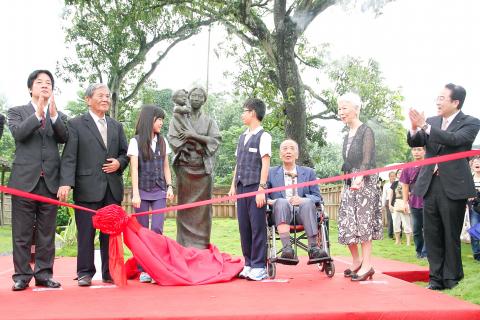|
Tainan honors Japan
engineer, wife
COMMEMORATION: The city unveiled a bronze statue
of Toyoki Yonemura, in honor of her dedication to her husband, who contributed
to Taiwan’s development
By Huang Po-lang and Jason Pan / Staff reporter, with staff
writer

Greater Tainan Mayor William Lai,
left, and guests attend a ceremony to unveil a statue of Toyoki Yonemura, the
wife of Yoichi Hatta, the designer of the Wushanto Reservoir, at the Hatta
Yoichi Memorial Park in Guantian District, Greater Tainan, on Sunday.
Photo: CNA
More than 300 dignitaries and guests
gathered in Greater Tainan on Sunday to commemorate Japanese civil engineer
Yoichi Hatta and his wife, Toyoki Yonemura, for their dedication and
contribution to Taiwan’s economy and agricultural development.
The event was held at the Yoichi Hatta Memorial Park at the Wushanto Reservoir
(烏山頭水庫), one of the projects designed and built by Hatta during his 32 years of
service in Taiwan from 1910 to 1942. A large Japanese delegation also attended
the event, including Hatta’s daughter-in-law, Ayako, and other family members.
Greater Tainan Mayor William Lai (賴清德) unveiled a bronze statue of Yonemura, a
commissioned artwork by Yoshiki Murai.
Organizers said the statue gives a full rendering of the couple’s moving life
story, with Yonemura as a virtuous woman and a loving wife, providing a resolute
supporting force to her husband.
“Hatta made great contributions to Taiwan with his construction of irrigation
networks and water reservoirs. Farmers’ lives and agricultural development
benefited enormously from his engineering projects... He turned barren lands
into productive granaries,” Lai said.
“He is also the link to the sister-city friendship between Greater Tainan and
Kanazawa City, Hatta’s hometown,” the mayor said.
Hatta, also known among Taiwanese as the “Father of the Chianan Irrigation
System (嘉南大圳),” was a civil engineering graduate from the then-Tokyo Imperial
University (now the University of Tokyo) in 1910, and came to Taiwan that year.
Working for the Japanese colonial government at the time, Hatta was the chief
engineer who designed and built a vast network of irrigation channels, measuring
more than 16,000km in length, to cover more than 100,000 hectares of farmland
around Chiayi and Tainan.
The project took 10 years and was completed in 1930. It raised the productivity
of the southern plains, with annual harvests of 83,000 tonnes of rice, sugarcane
and other crops, directly benefiting 600,000 farmers.
Hatta was killed in 1942, onboard a Japanese ship that was sunk in a submarine
attack during World War II. He was on his way to Manila, where the Japanese
government had sent him to develop agriculture in the Philippines.
His body was found, and after cremation, a portion of his ashes was taken to
Taiwan for burial in a gravesite at the reservoir.
Local residents had built a statue for the Japanese engineer in 1931 to pay
tribute to his contributions. However, they hid the statue for 40 years from
1941, fearing the Japanese government and later the Chinese Nationalist Party (KMT)
government would want to melt down the statue for war materials and for
political reasons.
Only when the political climate began to change in 1981 did local residents
uncover the statue for reinstallation at the Wushanto Reservoir park.
Despite her sadness at her husband’s death in 1942, Yonemura remained in Taiwan
with her children until the end of World War II.
Hatta and Yonemura raised two boys and six girls in their 32 years in Taiwan.
When Japan surrendered in 1945, all Japanese citizens were ordered to return
home, including all the Hatta children.
Yonemura committed suicide on Sept. 1, 1945, by jumping into the reservoir her
husband had built. Before her death, Yonemura had told one of the family members
that her life was devoted to her husband and she wanted to remain by her
husband’s side, so both of them could remain in the area in spirit to protect
the reservoir and the irrigation networks.
|
![]()
![]()
![]()